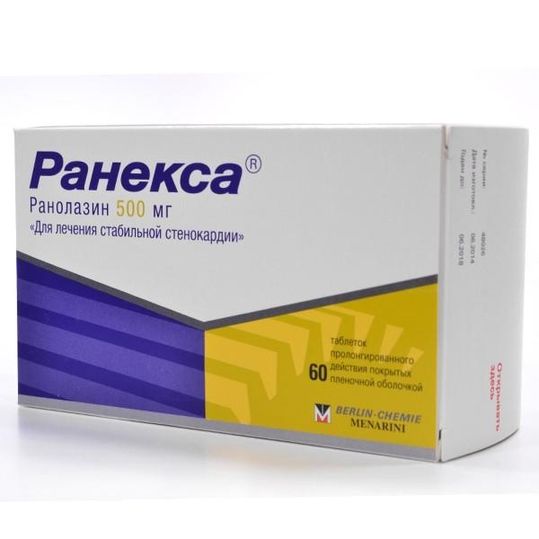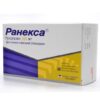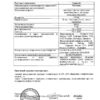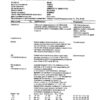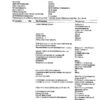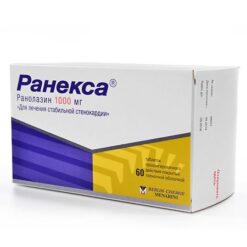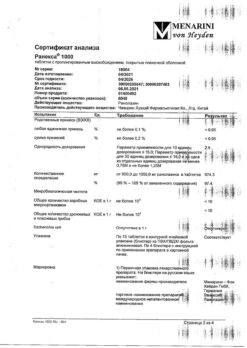No products in the cart.
Ranexa, 500 mg 60 pcs
€123.64 €103.03
Description
Pharmacodynamics
Ranexa is an antianginal drug. Ranolazine is an inhibitor of late sodium ion current in myocardial cells. Reducing intracellular sodium accumulation leads to a decrease in excess intracellular calcium ions. This reduces intracellular ionic imbalance during ischemia. Reducing excess intracellular calcium promotes myocardial relaxation and thus reduces diastolic tension of the ventricular wall.
The clinical evidence for inhibition of late sodium current under the action of ranolazine is a significant shortening of the QTc interval (QTc is the corrected QT value with regard to HR) and a positive effect on diastolic relaxation found in an open study involving patients with prolonged QT syndrome (patients with LQT-3 syndrome who have SCN5A ΔKPQ gene mutations). These effects of the drug are independent of changes in HR, BP, or the degree of vasodilation.
The incidence of angina attacks per week and consumption of short-acting nitroglycerin are significantly reduced with ranolazine compared with placebo, regardless of patient gender. No development of tolerance to ranolazine occurs during treatment. The incidence of angina attacks does not increase after abrupt discontinuation of the drug.
Ranolazine has a significant advantage over placebo in increasing time to angina attack and to ST-segment depression by 1 mm when taken at a dose of 500-1000 mg 2 times/day. The drug significantly improves exercise tolerance. A dose-effect relationship has been recorded for ranolazine: the antianginal effect was greater with a higher dose than with a lower dose.
When adding ranolazine (at 1500 mg or 2000 mg per day, divided into 2 doses, compared with placebo for 12 weeks) to treatment with atenolol 50 mg/day, either amlodipine 5 mg/day, or diltiazem 180 mg/day, the effectiveness of Ranex® has been shown to be superior to placebo in terms of duration of exercise for both study doses of the drug (24 sec longer compared to placebo). However, no differences were observed in the duration of tolerated exercise between the two doses of Ranex®. Ranex® showed dose- and plasma concentrations-dependent prolongation of the QTc interval (approximately 6 ms when taken 1000 mg twice daily), decreased T-wave amplitude and, in some cases, double-headed T-waves. The ECG findings in patients taking ranolazine are the result of both inhibition by the drug of the rate of the fast rectifying potassium current, which prolongs the ventricular action potential, and inhibition of the late sodium current, which shortens the ventricular action potential.
Population analysis has shown that the use of ranolazine in both patients with stable angina pectoris and healthy volunteers results in an average of 2.4 ms QTc prolongation relative to baseline at a plasma ranolazine concentration of 1000 ng/mL. The rate of QTc prolongation was higher in patients with clinically significant hepatic impairment.
Patients receiving ranolazine had a significantly lower incidence of arrhythmias compared with placebo, including pirouette-type ventricular tachycardia ≥8 contractions per episode.
Effects on hemodynamics In patients treated with ranolazine as monotherapy or in combination with other antianginal agents, a slight decrease in HR (< 2 bpm) and decrease in systolic BP (< 3 mm Hg) were noted.
Pharmacokinetics
absorption
. After oral administration, the Cmax of ranolazine in plasma is generally reached after 2-6 h. The average absolute bioavailability of ranolazine after oral administration is 35-50%, with a high degree of individual variability. When the dose is increased from 500 to 1000 mg 2 times/day, a 2.5-3-fold increase in AUC at equilibrium is observed.
When taking ranolazine 2 times/day, Css is usually reached within 3 days. In healthy volunteers, Cssmax is approximately 1,770 ng/mL, AUC0-12 at equilibrium averages 13,700 ng×h/mL after taking the drug at 500 mg 2 times/day. Food intake has no effect on the rate and completeness of absorption of ranolazine.
Distribution
Approximately 62% of ranolazine is bound to plasma proteins, primarily alpha-1 acidic glycoproteins, and slightly to albumin. The average Vss is about 180L.
Metabolism
Ranolazine undergoes rapid and almost complete metabolism in the liver. The most important pathways of metabolism of ranolazine are O-demethylation and N-dealkylation. Ranolazine is metabolized mainly by CYP3A4 isoenzyme and also by CYP2D6 isoenzyme. When administered at 500 mg 2 times/day in people with insufficient CYP2D6 isoenzyme activity, the AUC exceeds that of people with normal metabolic rate by 62%.
The similar difference for a dose of 1000 mg 2 times/day was 25%.
Elimation
Less than 5% of the administered dose of ranolazine is excreted unchanged in the urine and feces. Clearance of ranolazine is dose-dependent, decreasing with increasing dose. The T1/2 of ranolazine in equilibrium after oral administration is about 7 hours.
Pharmacokinetics in special clinical cases
In chronic heart failure (NYHA functional classes III-IV), there is an increase of approximately 1.3 times the plasma concentration of ranolazine.
In patients with mild, moderate and severe renal insufficiency, compared to volunteers with normal renal function, the AUC of ranolazine was on average 1.7-2 times higher. There was significant individual variability in the AUC in volunteers with renal impairment. AUC of pharmacologically active metabolites increased 5-fold in patients with severe renal failure. Duration of retention of ranolazine in plasma increased 1.2 times in patients with moderate renal insufficiency (CKR 30-60 ml/min). In patients with severe renal insufficiency (CC
AUC index of ranolazine does not change in patients with mild hepatic insufficiency, but it increases 1.8 times in case of moderate hepatic insufficiency (7-9 points by Child-Pugh classification); in such patients prolongation of QTc interval was more expressed. There is no experience with the use of ranolazine in patients with severe hepatic impairment (more than 9 Child-Pugh points).
Indications
Indications
Stable angina.
Pharmacological effect
Pharmacological effect
Pharmacodynamics
Ranexa is an antianginal drug. Ranolazine is an inhibitor of the late flow of sodium ions into myocardial cells. A decrease in intracellular sodium accumulation leads to a decrease in excess intracellular calcium ions. This reduces intracellular ion imbalance during ischemia. Reducing excess intracellular calcium promotes myocardial relaxation and thus reduces diastolic tension of the ventricular wall.
Clinical evidence of inhibition of late sodium current by ranolazine is a significant shortening of the QTc interval (QTc is the corrected QT value taking into account heart rate) and a positive effect on diastolic relaxation identified in an open study involving patients with long QT syndrome (patients with LQT-3 syndrome who have mutations in the SCN5A ΔKPQ gene). These effects of the drug do not depend on changes in heart rate, blood pressure, or the degree of vasodilation.
When using ranolazine, the frequency of angina attacks per week and the consumption of short-acting nitroglycerin were significantly reduced compared to placebo, regardless of the gender of the patients. During treatment, the development of tolerance to ranolazine does not occur. After abrupt discontinuation of the drug, the frequency of angina attacks does not increase.
Ranolazine has a significant advantage over placebo in increasing the time before the onset of an angina attack and until the onset of ST segment depression by 1 mm when taken at a dose of 500-1000 mg 2 times a day. The drug significantly improves exercise tolerance. For ranolazine, a dose-effect relationship was recorded: when taken at a higher dose, the antianginal effect was higher than when taken at a lower dose.
When ranolazine (1500 mg or 2000 mg per day, divided into 2 doses, compared with placebo for 12 weeks) was added to treatment with atenolol 50 mg/day, or amlodipine 5 mg/day, or diltiazem 180 mg/day, Ranexa® was proven to be more effective than placebo in terms of duration of physical activity for both study doses of the drug (24 seconds more compared to placebo). However, there were no differences in the duration of tolerated physical activity between the two doses of Ranexa®.
Effects detected by ECG: in patients treated with Ranexa®, a prolongation of the QTc interval (about 6 ms when taking 1000 mg 2 times a day), a decrease in the amplitude of the T wave and, in some cases, double-humped T waves were observed, depending on the dose and concentration of the drug in the blood plasma. ECG indicators in patients taking ranolazine are the result of both the drug’s inhibition of the speed rectifying potassium current, which lengthens the ventricular action potential, and inhibition of the late sodium current, which shortens the ventricular action potential.
A population-based analysis showed that the use of ranolazine in both patients with stable angina and healthy volunteers leads to a prolongation of QTc from baseline by an average of 2.4 ms at a ranolazine plasma concentration of 1000 ng/ml. In patients with clinically significant liver failure, the rate of QTc prolongation was higher.
Patients receiving ranolazine had a significantly lower incidence of arrhythmias compared to placebo, including torsade de pointes (TdP) ≥8 beats per episode.
The effect on hemodynamics in patients treated with ranolazine as monotherapy or in combination with other antianginal agents was a slight decrease in heart rate (< 2 beats/min) and a decrease in systolic blood pressure (< 3 mm Hg).
Pharmacokinetics
Suction
After oral administration of ranolazine, the Cmax of ranolazine in the blood plasma is usually achieved within 2-6 hours. The average absolute bioavailability of ranolazine after oral administration is 35-50%, with a high degree of individual variability. When the dose is increased from 500 to 1000 mg 2 times/day, a 2.5-3 fold increase in AUC at steady state is observed.
When taking ranolazine 2 times a day, Css is usually achieved within 3 days. In healthy volunteers, Cssmax is approximately 1770 ng/ml, AUC0-12 at steady state averages 13,700 ng×h/ml after taking the drug 500 mg 2 times a day. Food intake does not affect the rate and completeness of absorption of ranolazine.
Distribution
Approximately 62% of ranolazine is bound to plasma proteins, mainly alpha-1 acid glycoproteins, and slightly to albumin. Average Vss is about 180 HP.
Metabolism
Ranolazine undergoes rapid and almost complete metabolism in the liver. The most important metabolic pathways for ranolazine are O-demethylation and N-dealkylation. Ranolazine is metabolized mainly by the CYP3A4 isoenzyme, as well as the CYP2D6 isoenzyme. When taken 500 mg 2 times a day in people with insufficient activity of the CYP2D6 isoenzyme, the AUC value exceeds the same value for people with a normal metabolic rate by 62%.
A similar difference for a dose of 1000 mg 2 times/day was 25%.
Removal
Less than 5% of the administered dose of ranolazine is excreted unchanged in urine and feces. The clearance of ranolazine is dose dependent, decreasing as it increases. T1/2 of ranolazine at steady state after oral administration is about 7 hours.
Pharmacokinetics in special clinical situations
In chronic heart failure (III-IV functional classes according to the NYHA classification), the concentration of ranolazine in the blood plasma increases approximately 1.3 times.
In patients with mild, moderate and severe renal impairment, compared with volunteers with normal renal function, the AUC of ranolazine was on average 1.7-2 times higher. Significant individual variability in AUC values was noted in volunteers with renal failure. The AUC of pharmacologically active metabolites increased 5-fold in patients with severe renal failure. The duration of presence of ranolazine in the blood plasma increases 1.2 times in patients with moderate renal failure (creatinine clearance 30-60 ml/min). In patients with severe renal failure (SC
The AUC of ranolazine does not change in patients with mild liver failure, but increases 1.8 times in cases of moderate liver failure (7-9 points according to the Child-Pugh classification); in such patients there was a more pronounced prolongation of the QTc interval. There is no experience with the use of ranolazine in patients with severe liver failure (more than 9 points according to the Child-Pugh classification).
Special instructions
Special instructions
Ranexa® is intended for continuous therapy.
For patients with mild or moderate renal failure (creatinine clearance 30-80 ml/min), dose titration is recommended. Ranexa® is contraindicated in patients with severe renal failure (creatinine clearance <30 ml/min).
For patients with mild liver failure (5-6 points according to the Child-Pugh classification), dose titration is recommended. Ranexa® is contraindicated in patients with moderate (7-9 points according to the Child-Pugh classification) or severe (more than 9 points according to the Child-Pugh classification) liver failure.
Elderly patients may experience increased effects of Ranexa due to age-related decline in renal function. There is an increased incidence of side effects.
Dose selection for patients weighing less than 60 kg should be done with caution, because cases of side effects in such patients were observed more often.
Chronic heart failure
Dose selection for patients with moderate or severe chronic heart failure (NYHA functional class III-IV) should be done with caution. It is necessary to frequently monitor the development of side effects, and if necessary, the dose of the drug should be reduced or treatment discontinued.
QT prolongation
A population-based analysis of pooled data from patients and healthy volunteers showed that the QTc interval duration versus plasma concentration can be estimated to be 2.4 ms per 1000 ng/mL, which is approximately equal to an increase from 2 to 7 ms for the plasma concentration range corresponding to a dose of 500 to 1000 mg ranolazine taken twice daily. Therefore, caution should be exercised when treating patients with a history of congenital long QT syndrome, a family history of long QT interval, patients with known acquired QT prolongation, and patients receiving treatment with drugs that affect the QT interval.
Insufficient activity of the CYP2D6 isoenzyme
The risk of an increase in the incidence of side effects in these groups increases in patients with insufficient activity of the CYP2D6 isoenzyme (patients with “slow” metabolizers) compared with patients with a normal ability to metabolize the isoenzyme CYP2D6 (patients with “fast” metabolizers). Precautionary measures are designed to take into account the risk for patients with slow metabolism of the CYP2D6 isoenzyme and are necessary if the metabolic status of the CYP2D6 isoenzyme is unknown.
For patients with rapid metabolism of the CYP2D6 isoenzyme, such precautions are not necessary. In patients with identified (for example, by genotyping) or previously known intensive metabolic status of the CYP2D6 isoenzyme, Ranexa should be used with caution if the patient has a combination of several of the above risk factors.
Impact on the ability to drive vehicles and other mechanisms that require increased concentration
There have been no studies on the effect of ranolazine on the ability to drive vehicles and operate machinery. Given the possibility of developing side effects such as dizziness, blurred vision, confusion and hallucinations, caution should be exercised when driving vehicles and machinery, as well as when engaging in potentially hazardous activities that require increased concentration and speed of psychomotor reactions.
Active ingredient
Active ingredient
Ranolazine
Composition
Composition
Active ingredient:
ranolazine 500 mg;
Excipients:
microcrystalline cellulose,
copolymer of methacrylic acid and ethyl acrylate (1:1),
hypromellose,
magnesium stearate,
sodium hydroxide.
Film shell composition:
opadry II orange 85F93265 (macrogol 3350, partially hydrolyzed polyvinyl alcohol, talc, titanium dioxide, yellow iron oxide dye (E172), red iron oxide dye (E172), carnauba wax (trace amounts)).
Pregnancy
Pregnancy
Due to the lack of data, the use of Ranexa® during pregnancy and breastfeeding is contraindicated.
There are no data on the use of ranolazine in pregnant women.
The penetration of ranolazine into breast milk has not been studied.
Contraindications
Contraindications
Hypersensitivity to the components of the drug;
severe renal failure (creatinine clearance <30 ml/min);
liver failure of moderate (7-9 points according to the Child-Pugh classification) or severe (more than 9 points according to the Child-Pugh classification) degree;
simultaneous use with potent inhibitors of the CYP3A4 isoenzyme (itraconazole, ketoconazole, posaconazole, HIV protease inhibitors, clarithromycin, telithromycin, nefazodone);
simultaneous use with antiarrhythmic drugs of class I A (for example, quinidine) or class III (for example, dofetilide), other than amiodarone; sotalol;
children and adolescents under 18 years of age (the effectiveness and safety of the drug have not been established);
pregnancy;
breastfeeding period;
lactase deficiency, hereditary lactose intolerance, glucose-galactose malabsorption syndrome (only for 1000 mg);
With caution: mild liver failure (5-6 points according to the Child-Pugh classification); renal failure of mild or moderate severity (creatinine clearance 30-80 ml/min); age over 75 years; body weight less than 60 kg; chronic heart failure (III-IV functional classes according to the NYHA classification); history of congenital long QT interval syndrome, family history; diagnosed acquired QT prolongation; CYP2D6 isoenzyme deficiency; simultaneous use with inhibitors of the CYP3A4 isoenzyme of moderate strength (diltiazem, fluconazole, erythromycin); simultaneous use with inducers of the activity of the CYP3A4 isoenzyme (rifampicin, phenytoin, phenobarbital, carbamazepine, St. John’s wort (Hypericum perforatum); simultaneous use with P-glycoprotein inhibitors (verapamil, cyclosporine).
Side Effects
Side Effects
From the side of metabolism: infrequently – loss of appetite, anorexia, dehydration.
From the mental side: infrequently – anxiety, insomnia, clouding of consciousness, hallucinations; rarely – disorientation.
From the nervous system: often – dizziness, headache; infrequently – lethargy, fainting, hypoesthesia, drowsiness, tremor, postural dizziness; rarely – amnesia, confusion, loss of consciousness, parosmia.
From the organ of vision: infrequently – blurred vision, visual disturbances.
Hearing and labyrinthine disorders: infrequently – vertigo, tinnitus; rarely – hearing loss.
From the cardiovascular system: infrequently – a rush of blood to the face, a pronounced decrease in blood pressure; rarely – coldness of the extremities, orthostatic hypotension.
From the respiratory system: infrequently – shortness of breath, cough, nosebleeds; rarely – a feeling of constriction in the throat.
From the digestive system: often – constipation, nausea, vomiting; infrequently – abdominal pain, dryness of the oral mucosa, dyspepsia, flatulence, discomfort in the stomach; rarely – pancreatitis, erosive duodenitis, oral hypoesthesia.
From the skin and subcutaneous tissues: infrequently – itching, hyperhidrosis; rarely – allergic dermatitis, urticaria, cold sweat, skin rash, angioedema.
From the musculoskeletal system: uncommon – pain in the extremities, muscle spasms, swelling of the joints.
From the urinary system: infrequently – dysuria, hematuria, chromaturia; rarely – acute renal failure.
From the reproductive system: rarely – erectile dysfunction.
From laboratory parameters: infrequently – increased concentration of creatinine in the blood plasma, increased concentration of urea in the blood plasma, prolongation of the corrected QTc interval, thrombocytosis and leukocytosis, loss of body weight; rarely – increased activity of liver enzymes.
General disorders: often – asthenia; infrequently – fatigue, peripheral edema.
Interaction
Interaction
Concomitant use is contraindicated
Potent CYP3A4 inhibitors
Ranolazine is a substrate of cytochrome CYP3A4. Concomitant use with inhibitors of CYP3A4 isoenzyme activity increases the concentration of ranolazine in the blood plasma. Potential dose-dependent side effects (eg, nausea, dizziness) may also increase with increasing plasma concentrations of the drug. Simultaneous treatment with ketoconazole 200 mg 2 times a day increases the AUC of ranolazine by 3-3.9 times.
The simultaneous use of ranolazine and potent inhibitors of the CYP3A4 isoenzyme (for example, itraconazole, ketoconazole, voriconazole, posaconazole, HIV protease inhibitors, clarithromycin, telithromycin, nefazodone) is contraindicated.
Grapefruit juice is also a potent inhibitor of the CYP3A4 isoenzyme.
Concomitant use with caution
Medium strength inhibitors of the CYP3A4 isoenzyme
Diltiazem (180-360 mg 1 time / day), an inhibitor of the CYP3A4 isoenzyme of moderate strength, causes, depending on the dose, an increase in the average Css value of ranolazine in blood plasma by 1.5-2.4 times. For patients receiving diltiazem and other moderately potent CYP3A4 inhibitors (e.g., erythromycin, fluconazole), dose titration of ranolazine is recommended. A dose reduction of ranolazine may be necessary.
Inducers of CYP3A4 isoenzyme activity
Concomitant use of ranolazine with inducers of CYP3A4 isoenzyme activity (rifampicin, phenytoin, phenobarbital, carbamazepine, St. John’s wort (Hypericum perforatum)) may lead to a decrease in the effectiveness of the drug. For example, rifampicin (600 mg 1 time / day) reduces the Css of ranolazine in blood plasma by approximately 95%. Therefore, the use of ranolazine should not be started in patients receiving treatment with inducers of the CYP3A4 isoenzyme.
P-glycoprotein inhibitors
Ranolazine is a P-glycoprotein (P-gp) substrate. P-gp inhibitors (eg, cyclosporine, verapamil) increase ranolazine plasma concentrations. Verapamil (120 mg 3 times/day) increases the Css of ranolazine by 2.2 times. For patients receiving treatment with P-gp inhibitors, dose titration of ranolazine is recommended. A dose reduction of ranolazine may be necessary. On the other hand, ranolazine is a moderate P-gp inhibitor and a weak CYP3A4 inhibitor and may increase plasma concentrations of P-gp or CYP3A4 substrates. The tissue distribution of drugs that are transported by P-gp may be increased.
Substrates of the CYP2D6 isoenzyme
There is evidence that ranolazine is a weak inhibitor of the CYP2D6 isoenzyme. Taking ranolazine 750 mg 2 times a day increases the concentration of metoprolol in the blood plasma by 1.8 times. Therefore, when used simultaneously with ranolazine, the effect of metoprolol or other substrates of the CYP2D6 isoenzyme (for example, propafenone and flecainide, to a lesser extent, tricyclic antidepressants and antipsychotics) may be enhanced; therefore, a dose reduction of these drugs may be required.
Substrates of the CYP2B6 isoenzyme
The potential to inhibit the CYP2B6 isoenzyme has not been established. Caution is recommended when administered together with substrates of the CYP2B6 isoenzyme (for example, bupropion, efavirenz, cyclophosphamide).
Digoxin
There is evidence of an increase in the concentration of digoxin in the blood plasma by an average of 1.5 times with the simultaneous use of digoxin and ranolazine. Therefore, it is necessary to monitor digoxin levels at the beginning and after the end of ranolazine therapy.
Substars of the CYP3A4 isoenzyme
Ranolazine is a weak inhibitor of the CYP3A4 isoenzyme, which may lead to increased concentrations of CYP3A4 isoenzyme substrates in the blood plasma and require dose adjustment of sensitive CYP3A4 isoenzyme substrates (e.g., simvastatin, lovastatin) and CYP3A4 isoenzyme substrates with a narrow therapeutic index (e.g., cyclosporine, tacrolimus, sirolimus, everolimus).
Simvastatin
The metabolism and clearance of simvastatin is highly dependent on the CYP3A4 isoenzyme. Taking ranolazine 1000 mg 2 times a day increases the concentration of simvastatin lactone, simvastatin acid, which increases the inhibition of HMG-CoA reductase by 1.4-1.6 times. Taking simvastatin in high doses is associated with the development of rhabdomyolysis, and cases of rhabdomyolysis have also been described with the simultaneous use of ranolazine and simvastatin. The maximum dose of simvastatin for patients concomitantly taking ranolazine should not exceed 20 mg/day. For other statins metabolized by the CYP3A4 isoenzyme (lovastatin), dose limitation is possible.
Tacrolimus, cyclosporine, sirolimus, everolimus
An increase in plasma concentrations of tacrolimus, a substrate of the CYP3A4 isoenzyme, was observed in patients receiving ranolazine. When tacrolimus and ranolazine are used concomitantly, it is recommended to monitor the concentration of tacrolimus in the blood plasma and, if necessary, adjust the dose. This approach is also recommended for other CYP3A4 substrates with a narrow therapeutic index (for example, cyclosporine, sirolimus, everolimus).
Drugs that prolong the QT interval
There is a theoretical possibility that with simultaneous use of ranolazine and other drugs that prolong the QT interval, a pharmacodynamic interaction may occur and the risk of developing ventricular arrhythmias may increase. These drugs include certain antihistamines (eg, terfenadine, astemizole, mizolastine), certain antiarrhythmics (eg, quinidine, disopyramide, procainamide), and erythromycin and tricyclic antidepressants (eg, imipramine, doxepin, amitriptyline).
Overdose
Overdose
Symptoms: dizziness, nausea and vomiting, diplopia, lethargy, fainting. Symptoms may increase with increasing dose.
Treatment: symptomatic therapy. Within 30 min. after taking the drug, measures can be taken to prevent its absorption from the gastrointestinal tract (gastric lavage, use of activated charcoal).
Hemodialysis is ineffective.
Storage conditions
Storage conditions
At a temperature not exceeding 25 °C.
Shelf life
Shelf life
4 years.
Manufacturer
Manufacturer
Berlin-Chemie AG/Menarini-Von Heiden GmbH, Germany
Additional information
| Shelf life | 4 years. |
|---|---|
| Conditions of storage | At a temperature not exceeding 25 °C. |
| Manufacturer | Menarini-Von Heyden GmbH, Germany |
| Medication form | sustained release tablets |
| Brand | Menarini-Von Heyden GmbH |
Other forms…
Related products
Buy Ranexa, 500 mg 60 pcs with delivery to USA, UK, Europe and over 120 other countries.

